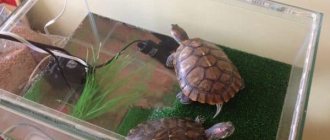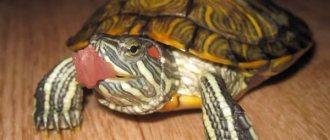The most common disease that can appear at any age in a red-eared slider is fungus . If the first signs appear, you should immediately begin to treat the disease. At the same time, it should be remembered that the fungus can be transmitted from an animal to a person. The first sign indicating this disease is the appearance of a whitish coating on the turtle's shell, as well as peeling of the epithelium. As a rule, several reasons contribute to the appearance of such an infectious disease.
Causes of fungus
What is most interesting is that in natural conditions turtles practically do not get sick from the fungus. Some experts believe that the reason for this is captivity, in which basic instincts may be dulled, as well as a decrease in the effectiveness of the immune system.
In addition, a fungus in a pet can develop against the background of diseases such as pneumonia, tympany, as well as other negative factors that reduce the resistance of the immune system. Plus, this can be caused by the conditions of detention, as well as a meager diet. A lack of various vitamins, as well as inconsistency in temperature conditions, can serve as the trigger that will give rise to the development of infectious diseases, including fungus.
Most experienced owners can predict the appearance of fungus in advance, especially during periods after recovery from acute respiratory infections or other ailments that had to be treated with antibiotics. In this case, they prepare in advance to prevent the occurrence of mycosis. If you do not carry out such activities, the disease will soon remind itself and then it will be very difficult to cope with it.
The following types of fungi should be noted:
- Aspergillus spp;
- Candida spp;
- Fusarium incornatum;
- Mucor spp;
- Panicillium spp;
- Paecilomyces lilacinus.
As a rule, a fungal infection thrives and actively multiplies in conditions of high humidity. When the water in the aquaterrarium warms up above +26°C, then there is a high probability of fungal infection, especially during the molting period, when the skin has minimal resistance, both mechanical and antiviral. In addition, at elevated water temperatures, the turtle spends a lot of time in the water without crawling onto land to warm up and dry out. Therefore, the temperature of the water should be maintained at +22°C-+26°C, and the temperature of the island +28°C-+32°C. Then the turtle will simply be drawn to the island to receive a certain dose of heat. Here it will dry out quickly and then the fungus is unlikely to be able to develop.
When arranging the habitat of the red-eared turtle, one should take into account such a thing as sufficient space for both living and rest. There should be enough space on the island for the turtle to feel comfortable and have the desire to constantly climb to this island. To make it convenient for her to do this, you should organize a smooth rise from the water. You should always remember that the reptile will grow up and it simply needs appropriate comfort. This indicates that you should not skimp on living space. You should always be aware of this, especially before purchasing a pet.
Bone diseases of red-eared turtles: symptoms and treatment (photo)
Rickets, detachment of parts of the shell and its softening are caused by the same reasons: poor absorption of calcium and other auxiliary microelements, as well as a lack of ultraviolet rays.
A symptom of rickets is a violation of the structure and shape of the bones, as a result of which thickenings appear on them. Determining the softness of bones at an early stage is quite difficult, but possible. To do this, you just need to take a closer look at your pet’s behavior. If your red-eared slider looks lethargic and doesn't move much, these are clear signs of a bone problem. As for the softening of the shell, its symptoms are immediately noticeable. First, its keratinized particles peel off, and then it becomes completely soft and even changes its shape.
Before treating bone diseases of red-eared turtles (see photo below), you should consult a veterinarian. He will help with advice and select the necessary complex of vitamins for the reptile, containing calcium and other useful microelements. These are, as a rule, “Eleovit”, “Intravit” and “Multivit”. If necessary, he may also prescribe additional treatment.
For these diseases, it will be useful to introduce small fish with bones into your pet’s diet. In addition, to prevent and treat any bone disease in red-eared turtles, it is helpful to place them under a lamp emitting ultraviolet rays from time to time.
Fungus treatment
It is quite easy to rid a turtle of a whole “bouquet” of infectious diseases if you follow the appropriate recommendations.
- Since there are several types of microbiotics for fungal infections, only a specialist can determine an accurate diagnosis. To do this, you will have to take a blood test and a smear. Only based on the test results can a conclusion be made about the type of fungal disease.
- Regardless of what kind of fungus the turtle has, it is necessary to completely disinfect the aquaterrarium, as well as the objects inside it.
- If several individuals are kept, the sick turtle is removed until the disease disappears. The turtle can be cured in two weeks or 2 months, depending on the severity of the disease.
- You need to add Methylene Blue to the water. Its quantity is selected so that the water is slightly colored and has a slightly bluish tint. If the aquaterrarium has a carbon filter, then it is better to turn it off, otherwise the effect of the drug will be neutralized.
- A sick turtle undergoes preventive and therapeutic actions. To do this, it is placed in a bath with oak bark tincture for 1 hour. This procedure is carried out daily until the fungus completely disappears. The color of the liquid should match the shade of regular tea. In severe cases, the concentration of oak bark can be increased.
- The turtle should be irradiated daily with a UV lamp. This radiation (ultraviolet) can destroy the infection.
- In addition to the above measures, the use of ointments is required. Ointments such as Triderm, Terbinofin, Akriderm and Nizoral are suitable for this. The turtle is smeared overnight, leaving it in a dry, warm place.
- In parallel with the treatment procedures, the sick turtle is prescribed a diet rich in vitamins and nutrients.
As a rule, such instructions refer to the main treatment regimen, although treatment with other methods is also possible. In any case, it is better to consult a veterinarian and not start self-treatment, which can lead to unpredictable consequences.
Signs and causes of the development of ailments
Red-eared turtles are compact, cute reptiles that have won the universal love of people and have become popular pets. In nature, red-eared turtles live 40-50 years. Given proper maintenance and a proper diet in captivity, these cute reptiles can live just as long. The impressive life expectancy of turtles is due to the animals' unpretentiousness and enviable health, but owners cannot always take proper care of their pet, as a result of which diseases develop in red-eared turtles.
The reasons why diseases of red-eared turtles occur are considered to be:
- Close contact with infected animals.
- Injuries and damage.
- Stress due to a change in environment or climate.
- Incorrect feeding or lack of vitamins.
- Unsuitable temperature.
Due to the fact that reptiles are quiet and silent pets, owners do not immediately notice illnesses in red-eared turtles. You can determine if your pet is sick by
the following external signs:
- The pet has become apathetic and does not demonstrate mobility.
- The red-eared slider's eyes are swollen and there is greenish mucus.
- Blood clots are noticeable in the stool.
- The appearance of white spots on the shell of a red-eared turtle.
- The pet lies on the bottom for a long time without moving.
- The red-eared slider's shell is peeling off.
If you notice these symptoms, you should immediately go to a veterinarian, who will explain what to do and establish treatment.
Prevention methods
There is one truth that must be adhered to. She claims that it is easier to prevent a disease than to treat it. Therefore, in order not to have to undergo treatment, it is better to regularly carry out preventive measures, which is what experienced owners do. This is especially true when the animal has gastrointestinal disorders or the turtle has contracted an acute respiratory infection and its body spends a lot of energy fighting these ailments.
Prevention is carried out every few months, or maybe more often, depending on the conditions. As a preventative measure, you can use oak bark baths or etch the aquaterrarium with Methylene Blue.
Carrying out preventive measures does not in any way indicate that there is no need to keep the animal in normal conditions. Normal conditions are appropriate temperature conditions, cleanliness and an appropriate diet. Without these three components, it is unlikely that it will be possible to raise a healthy animal. After all, in addition to fungus, pets are also plagued by other, no less serious diseases. All of them are directly related to both nutrition and living conditions.
How long should you walk your turtle?
It is recommended that the place for walking be away from the roadway, and that dogs, cats, birds and children should not interfere with the walk. The duration of the walk should not exceed 30 minutes, otherwise your pet may get tired.
Interesting materials:
How to upload your track to Tiktok? How to upload your music to Tiktok? How to log in via telnet? How to log into the Samsung cloud? How to log into the router via telnet? How to log into the router via SSH? How to log into Rutracker 2021? How to access the Flibusta website? How to access the UCHI ru website? How to log into the App Store account?
What do you need for swimming?
They bathe the Central Asian turtle 1 or 2 times a week.
Turtles are very sensitive to chemicals that can cause allergies in them. So skip the shampoo. You won't need a hairdryer either.
But if your pet is very dirty, you will have to use baby or liquid hypoallergenic soap to wash the shell.
Before bathing, stock up on a basin and a brush, foam sponge or rag. When bathing, it is advisable to place a lamp near the bath to avoid colds from hypothermia.
Prepare a supply of warm water. Turtles love to use the bathtub instead of the toilet. Therefore, you will have to change the water in the basin.
If you have hard water, add chamomile infusion to soften it.
Pneumonia
Pneumonia in a red-eared turtle is a serious ailment that requires a responsible attitude from the owner. Pneumonia in turtles occurs due to low temperature or lack of ventilation. Symptoms are considered:
- Discharge of mucus from the nose and swollen eyes.
- The pet breathes rapidly through its mouth and swims sideways.
- Lethargy and refusal to eat.
If you notice the above symptoms, you should contact your veterinarian to prescribe medication. Pneumonia in red-eared turtles is usually eliminated by injections of antibiotics, the dosage of which is determined by a specialist.
If it is impossible to see a doctor, then you should treat your pet with folk remedies. An infusion of chamomile will help get rid of pneumonia: after brewing the flower, the reptile is held over steam. After the infusion has cooled to a comfortable temperature, the pet is immersed in the decoction and left for 20-30 minutes. During treatment, the temperature of the liquid should not be lower than 30C.
Nutritional conditions of adults
When keeping a red-eared slider at home, you should know that they feed in water. That is, the food will have to be poured directly into the aquarium. Monitor what she has eaten and remove any leftover food. Some breeders organize a special separate container for this purpose. The pet is fed in it, waits for a bowel movement, and is transferred back. At this moment it is very convenient to immediately take care of the owner of the aquarium.
Adults happily eat bloodworms, squid, and meat. You can give thawed frozen fish along with bones - this will solve the problem of calcium deficiency. Perch fish, if it is large enough, should be disassembled and the rib part of the bones removed, and the spine simply cut. Fish bones are a must in the diet. Shrimp are an excellent way out, since reptiles need chitin, which is contained in large quantities in the shell of shrimp. Also, your pet can be treated to special crustaceans, and you should not be afraid of their hard house.
Raw liver should be given once a week; if your pet enjoys eating it, you need to reduce the dose of vitamins. This point, as well as the question of the amount of vitamins required for your pet, should be discussed with your veterinarian.
It is also necessary to include plant foods in the diet, this could be fresh cabbage, spinach, and greens. The main thing is to wash the plants thoroughly.
You can tell that a turtle is hungry by its behavior. A hungry turtle rummages through the rocks, actively explores the corners of the aquarium, and behaves restlessly compared to its usual state, at a time of day when it would usually be asleep.
Reptile Handling
After learning how to care for a red-eared turtle, read the rules for handling it:
- Always hold the reptile with both hands to prevent it from slipping and falling. The slow-looking turtle can hiss, bite and defecate.
- After handling the reptile, be sure to wash your hands with soap. Make sure children do this.
- A turtle has no place in the kitchen or dining room. It is unacceptable to wash it and accessories in the sink.
Red-eared turtles tolerate loneliness well. In the company of relatives, they strive to take a dominant position, which is accompanied by aggression. As a result, injuries appear on the animal's body. The construction of partitions will allow you to divide the terrarium space into separate zones for each individual.
Signs of diseases
The shell can tell about many diseases that an amphibian animal may suffer from. For this reason, owners should inspect this part of the body from time to time so as not to miss suspicious signs.
Rickets or vitamin D3 deficiency
A turtle's soft shell may indicate that the animal lacks calcium and vitamin D3. In this case, other unpleasant symptoms may appear:
- deformation of limbs and shell;
- increased bone fragility;
- prolapse of the cloaca;
- the reptile cannot rise to its feet normally;
- redness of the mucous membranes of the eyes is noted;
- disruption of the digestive system;
- change in bite.
All these signs pose a serious danger to the life of the turtle. If treatment is not started in time, serious consequences can occur, including death.
So what should you do if your turtle has a soft shell? It is advisable to review the diet at home and include feed mixtures with high levels of calcium, as well as other vitamins. In addition, you need to contact a veterinarian.
How to bathe
How to properly bathe a land turtle? First you need to prepare the water. It needs to be warmed up to a warm state, and its temperature regime must be observed. Its temperature should be 30-40 degrees. If it is higher, then burns may appear on the reptile’s skin, and if it is lower, the animal may catch a cold.
So how to properly wash an amphibian animal:
- It is recommended to pour enough water into the basin so that it reaches the base of the neck. In this case, the reptile’s nostrils should be above the surface of the water;
- You should not leave the animal in the water, because it may drown;
- First you need to wash the shell. This procedure is performed using a soft brush, sponge or rag;
- in order to wash off all the dirt, you can use a little soap, but it should not get into your pet’s eyes and nostrils;
- It is necessary to keep freshwater in water for half an hour;
- After this, you need to take it out of the water, wipe it dry with a towel and place it in the sun or near a lamp for 30 minutes. And then the temperature gradually decreases.
It is advisable to rinse your pet under the tap after washing, this will help wash off all the dirt faster. And also, under running water, the reptile always stretches its neck, and this provides access to all hard-to-reach places that can be washed well.
After your pet has dried completely, the surface of the shell and skin should be lubricated with vegetable oil. It can be rubbed with sunflower, olive or peach oil. All these procedures will help improve the structure of the skin and shell, and will also have a positive effect on the condition of the pet.
Lamps and lighting
In the wild, red whales live in the tropics, so sunbathing plays a very important role in their lives. Thanks to the sun's rays, reptiles receive a dose of ultraviolet radiation, which is involved in the process of calcium absorption.
At home, the red-eared turtle needs artificial sources of ultraviolet light and heat. For these purposes, 3 types of lamps are used:
- Ultraviolet (UV).
A lamp with a power of 5% UVB is enough for turtles, while larger individuals need a model with a power of 10% UVB. Such irradiation prevents the development of rickets and improves metabolism. - Warming
. Used all day for warmth when the reptile is doing its business in the water or on land. - Infrared
. Unlike an incandescent heating lamp, it does not provide enough light. It is used only for the purpose of heating the aquaterrarium at night, when the temperature drops below acceptable levels.
When installing and using a heating and UV lamp, it is important:
- Place the equipment at a distance of at least 30 cm from land. At closer proximity, the pet's retina is at risk.
- Take care of waterproofing. Flying splashes may damage the lamp.
- Maintain a working time of 10-12 hours.











